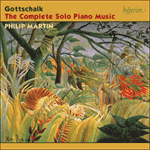Richard Hoffman remembered Gottschalk and Thalberg playing duets on two pianos at a concert in New York in the 1850s: ‘One in particular, on themes from
Trovatore, composed by both of them, and which I have never seen in print, was wonderfully effective and created the most tremendous furore and excitement. A remarkable double shake which Thalberg played in the middle of the piano while Gottschalk was flying all over the keyboard in the “Anvil Chorus”, produced the most prodigious volume of tone ever heard from the piano.’ Alas, no manuscript survives of this marvel but here, perhaps, is the next best thing. It contains no ‘Anvil Chorus’ but, unlike Liszt’s ‘Miserere paraphrase’ of a few years earlier, uses Leonora’s expressive ‘D’amor sull’ ali rosee’ as an introduction. (Her Act 4 aria immediately precedes it in the opera, after all.) Liszt’s version, though, conveys the underlying drama of the scene far more cogently than Gottschalk (albeit with some fairly de trop gestures). Gottschalk’s is purely a bravura display which happens to have tunes by Verdi. It is highly effective, with an ingenious use (as in the Liszt) of Thalberg’s device of alternating the playing of the melody between the two thumbs. This leaves Gottschalk free to accompany the theme with semiquaver octave sextuplets in the treble’s zenithal region while the left hand gets on with the harmonization and rhythmic pulse.
from notes by Jeremy Nicholas © 1994
Richard Hoffman se souvenait que Gottschalk et Thalberg avaient joué des duos à deux pianos dans un concert, à New York, dans les années 1850: «Un, en particulier, sur des thèmes du
Trovatore, qu’ils avaient composé ensemble, et que je n’ai jamais vu imprimé, produisait beaucoup d’effet et avait provoqué un débordement d’enthousiasme. Un remarquable double trille, que Thalberg jouait dans le registre du milieu tandis que Gottschalk faisait courir ses mains d’un bout à l’autre du clavier dans le “Chœur de l’enclume”, produisait le plus extraordinaire volume de son qu’on ait jamais entendu sortir d’un piano.» Hélas, aucun manuscrit de cette merveille ne nous est parvenu, mais voici, peut-être, un pis-aller. Il n’y a pas de «Chœur de l’enclume», mais, à la différence de la «Paraphrase du Miserere» de Liszt qui date de quelques années plus tôt, Gottschalk utilise l’expressif «D’amor sull’ali rosee» de Leonora comme introduction. (Son air de l’Acte IV le précède d’ailleurs immédiatement dans l’opéra.) Mais la version de Liszt exprime le drame sous-jacent de cette scène avec beaucoup plus de force que celle de Gottschalk (bien qu’avec quelque exagération). La version de Gottschalk est une simple exhibition de bravoure qui se trouve utiliser des mélodies de Verdi. Elle fait beaucoup d’effet, en usant avec astuce (comme chez Liszt) de la technique de Thalberg qui fait alterner le jeu de la mélodie entre les deux pouces. Cela permet à Gottschalk d’accompagner le thème avec des sextolets de double-croches en octaves dans le haut du clavier tandis que la main gauche se charge de l’harmonisation et de la pulsation rythmique.
extrait des notes rédigées par Jeremy Nicholas © 1994
Français: Madeleine Jay
Richard Hoffman gab folgende Erinnerung an das vierhändige Klavierspiel von Gottschalk und Thalberg bei einem Konzert in New York in den 1850er Jahren wieder: „Besonders ein Duett über Motive aus dem
Trovatore, welches von beiden komponiert war und welches ich nie gedruckt gesehen habe, war wunderbar eindrucksvoll und rief das wildeste Furore und die hellste Begeisterung hervor. Ein bemerkenswerter Doppeltriller, den Thalberg in der Klaviermitte spielte, während Gottschalk im “Amboßrefrain” geradezu über die gesamte Tastatur flog, erzeugte die ungeheuerste Lautstärke, die jemals von einem Klavier her an unsere Ohren drang.“ Bedauerlicherweise ist kein Manuskript zu diesem Wunderwerk erhalten geblieben, aber hier haben wir vielleicht das Nächstbeste. Zwar enthält das vorliegende Stück keinen „Amboßrefrain“, doch benutzt Gottschalk, im Gegensatz zu Liszts wenige Jahre zuvor geschriebener „Miserere Paraphrase“, Leonoras ausdrucksvolles „D’amor sull’ ali rosee“ als Einleitung. (Ihre Arie im 4. Akt geht dem Miserere in der Oper schließlich unmittelbar voran.) Liszts Version gibt jedoch die unterschwellige Spannung der Szene viel überzeugender wieder als Gottschalk (sei es auch mit einigen ziemlich übertriebenen Gesten). Gottschalks Variante ist ein reines Bravourstück, das zufällig Melodien von Verdi verwendet. Es ist höchst wirkungsvoll, mit seinem genialen Gebrauch von Thalbergs Kunstgriff (wie er auch bei Liszt zu finden ist), die Melodie im Wechsel zwischen den beiden Daumen zu spielen. Dies gibt Gottschalk die Freiheit, das Thema in der höchsten Region des Soprans mit Sechzehntel-Oktavensextolen zu begleiten, während seine Linke sich mit Harmonisierung und rhythmischem Taktschlag beschäftigt.
aus dem Begleittext von Jeremy Nicholas © 1994
Deutsch: Angelika Malbert


 Gottschalk: The Complete Solo Piano Music
Gottschalk: The Complete Solo Piano Music
